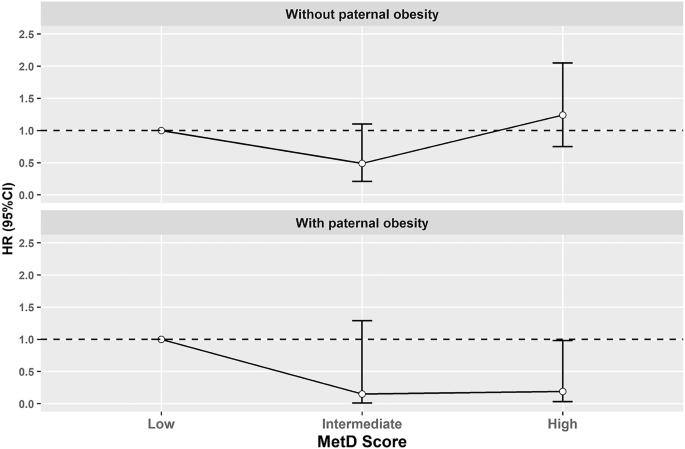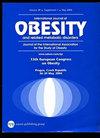甲基供体营养素消耗与肥胖发生率:是否受父母肥胖影响?CUME研究的4年随访结果。
IF 3.8
2区 医学
Q1 ENDOCRINOLOGY & METABOLISM
引用次数: 0
摘要
DNA甲基化对甲基供体营养物质(MetD)的消耗是不稳定的,并且可能调节与肥胖相关的基因表达。目的:评价美德芬消费与肥胖发病率的关系,并检验家族病史在这种关系中的调节作用。方法:这项纵向研究纳入了米纳斯吉拉斯州大学队列(CUME研究)的1205名参与者,在为期4年的随访(2016- 2020)中评估了肥胖的发生率。MetD营养素(B2、B6、B9、B12、胆碱、甜菜碱和蛋氨酸)的摄入量通过对人群进行半定量食物频率问卷调查来估计。计算一个MetD评分,然后根据样本的三分位数分为低、中、高分。父亲和母亲患有肥胖症,父母患有肥胖症(父亲和母亲患有该病)的存在是自我报告的。用Cox回归检验相关性。结果:随访发现肥胖89例(7.4%)。食用B2的第三四分位数和食用B9和胆碱的第二四分位数的参与者,患肥胖症的风险分别降低了60% (95%CI: 0.20-0.79)、52% (95%CI: 0.26-0.89)和52% (95%CI: 0.24-0.93)。呈现中等MetD评分也与较低的结局风险相关(HR: 0.40;95%置信区间:0.18—-0.84)。然而,高MetD评分与肥胖发生率之间的关联仅在父亲有疾病史的个体中观察到(HR: 0.19;95%置信区间:0.03—-0.98;p-相互作用= 0.022)。结论:中等水平的B2、B9和胆碱摄入与较低的肥胖风险相关,而在父亲有肥胖史的人群中,较高的MetD评分与较低的结局风险相关。本文章由计算机程序翻译,如有差异,请以英文原文为准。

Consumption of methyl donor nutrients and incidence of obesity: is the association influenced by parent’s obesity? Results of 4 years of follow-up of the CUME study
DNA methylation is labile to the consumption of methyl donor nutrients (MetD), and may modulate gene expression associated with obesity. To evaluate the association between MetD consumption and the incidence of obesity, as well as to test the modifying role of the effect of the family history of the disease in this association. This longitudinal study, with 1205 participants of the Cohort of Universities of Minas Gerais (CUME study), evaluated the incidence of obesity in a 4-year follow-up (2016– 2020). The intake of MetD nutrients (B2, B6, B9, B12, choline, betaine, and methionine) was estimated through a semi-quantitative food frequency questionnaire validated for the population. A MetD score was calculated and later stratified into low, intermediate, and high scores according to the tertiles of the sample. The presence of father and mother with obesity and parental obesity (father and mother with the disease) was self-reported. Associations were tested by Cox regression. 89 (7.4%) cases of obesity were identified during follow-up. Participants who were in the third quartile of B2 consumption and the second quartile of B9 and choline consumption presented 60% (95%CI: 0.20–0.79), 52% (95%CI: 0.26–0.89) and 52% (95%CI: 0.24–0.93) less risk of developing obesity, respectively. Presenting an intermediate MetD score was also associated with a lower risk for the outcome (HR: 0.40; 95%CI: 0.18–0.84). However, the association between high MetD score and obesity incidence was observed only among individuals with a history of the disease in the father (HR: 0.19; 95%CI: 0.03–0.98; p-interaction = 0.022). Intermediate consumption of B2, B9, and choline was associated with a lower risk of obesity, while a high MetD score was associated with reduced risk of outcome in those with a history of paternal obesity.
求助全文
通过发布文献求助,成功后即可免费获取论文全文。
去求助
来源期刊

International Journal of Obesity
医学-内分泌学与代谢
CiteScore
10.00
自引率
2.00%
发文量
221
审稿时长
3 months
期刊介绍:
The International Journal of Obesity is a multi-disciplinary forum for research describing basic, clinical and applied studies in biochemistry, physiology, genetics and nutrition, molecular, metabolic, psychological and epidemiological aspects of obesity and related disorders.
We publish a range of content types including original research articles, technical reports, reviews, correspondence and brief communications that elaborate on significant advances in the field and cover topical issues.
 求助内容:
求助内容: 应助结果提醒方式:
应助结果提醒方式:


